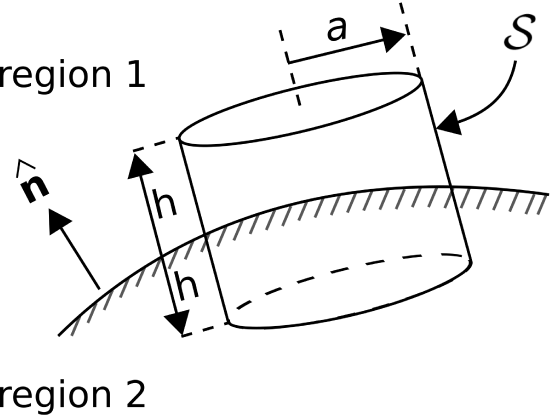7.10: Boundary Conditions on the Magnetic Flux Density (B)
( \newcommand{\kernel}{\mathrm{null}\,}\)
selected template will load here
This action is not available.
( \newcommand{\kernel}{\mathrm{null}\,}\)
In homogeneous media, electromagnetic quantities vary smoothly and continuously. At an interface between dissimilar media, however, it is possible for electromagnetic quantities to be discontinuous. Continuities and discontinuities in fields can be described mathematically by boundary conditions and used to constrain solutions for fields away from these interfaces.
In this section, we derive the boundary condition on the magnetic flux density B at a smooth interface between two material regions, as shown in Figure 7.10.1.1 The desired boundary condition may be obtained from Gauss’ Law for Magnetic Fields (GLM):
∮SB⋅ds=0
where S is any closed surface. Let S take the form of cylinder centered at a point on the interface, and for which the flat ends are parallel to the surface and perpendicular to ˆn, as shown in Figure 7.10.1. Let the radius of this cylinder be a, and let the length of the cylinder be 2h.
 Figure 7.10.1: Determination of the boundary condition on B at the interface between material regions (© CC BY SA 4.0; K. Kikkeri)
Figure 7.10.1: Determination of the boundary condition on B at the interface between material regions (© CC BY SA 4.0; K. Kikkeri)
From GLM, we have
∮SB⋅ds=∫topB⋅ds+∫sideB⋅ds+∫bottomB⋅ds=0
Now let us reduce h and a together while (1) maintaining a constant ratio h/a≪1 and (2) keeping S centered on the interface. Because h≪a, the area of the side can be made negligible relative to the area of the top and bottom. Then, as h→0, we are left with
∫topB⋅ds+∫bottomB⋅ds→0
As the area of the top and bottom sides become infinitesimal, the variation in B over these areas becomes negligible. Now we have simply:
B1⋅ˆnΔA+B2⋅(−ˆn)ΔA→0
where B1 and B2 are the magnetic flux densities at the interface but in regions 1 and 2, respectively, and ΔA is the area of the top and bottom sides. Note that the orientation of ˆn is important – we have assumed ˆn points into region 1, and we must now stick with this choice. Thus, we obtain
ˆn⋅(B1−B2)=0
where, as noted above, ˆn points into region 1.
The normal (perpendicular) component of B across the boundary between two material regions is continuous.
It is worth noting what this means for the magnetic field intensity H. Since B=μH, it must be that
The normal (perpendicular) component of H across the boundary between two material regions is discontinuous if the permeabilities are unequal.

